tyre pressure Hyundai Sonata 2015 - RHD (UK, Australia) User Guide
[x] Cancel search | Manufacturer: HYUNDAI, Model Year: 2015, Model line: Sonata, Model: Hyundai Sonata 2015Pages: 504, PDF Size: 10.88 MB
Page 449 of 504
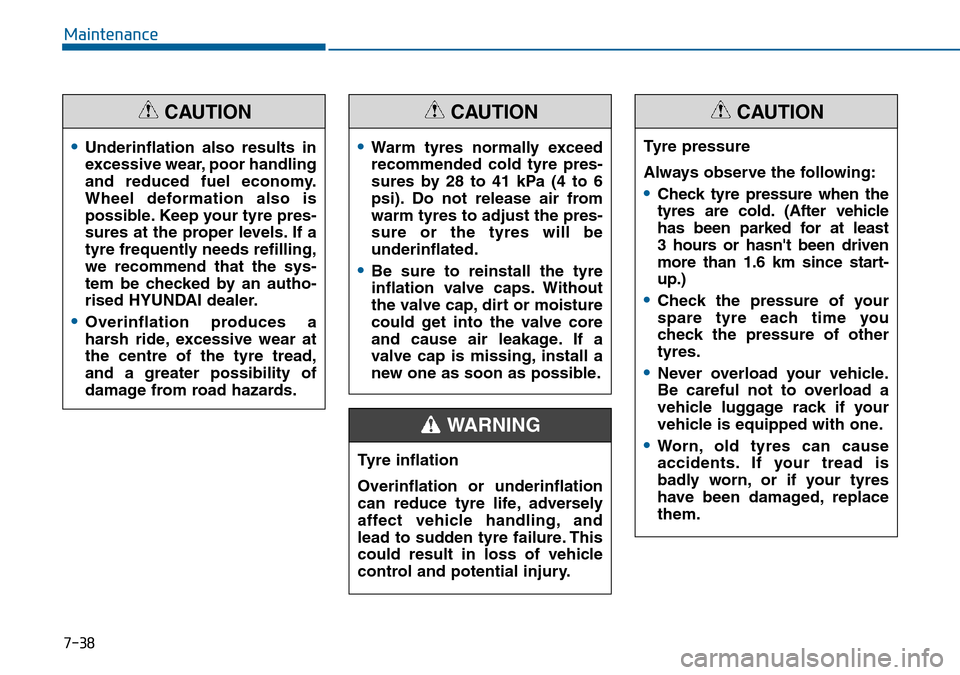
7-38
Maintenance
•Underinflation also results in
excessive wear, poor handling
and reduced fuel economy.
Wheel deformation also is
possible. Keep your tyre pres-
sures at the proper levels. If a
tyre frequently needs refilling,
we recommend that the sys-
tem be checked by an autho-
rised HYUNDAI dealer.
•Overinflation produces a
harsh ride, excessive wear at
the centre of the tyre tread,
and a greater possibility of
damage from road hazards.
CAUTION
•Warm tyres normally exceed
recommended cold tyre pres-
sures by 28 to 41 kPa (4 to 6
psi). Do not release air from
warm tyres to adjust the pres-
sure or the tyres will be
underinflated.
•Be sure to reinstall the tyre
inflation valve caps. Without
the valve cap, dirt or moisture
could get into the valve core
and cause air leakage. If a
valve cap is missing, install a
new one as soon as possible.
CAUTION
Tyre pressure
Always observe the following:
•Check tyre pressure when the
tyres are cold. (After vehicle
has been parked for at least
3 hours or hasn't been driven
more than 1.6 km since start-
up.)
•Check the pressure of your
spare tyre each time you
check the pressure of other
tyres.
•Never overload your vehicle.
Be careful not to overload a
vehicle luggage rack if your
vehicle is equipped with one.
•Worn, old tyres can cause
accidents. If your tread is
badly worn, or if your tyres
have been damaged, replace
them.
CAUTION
Tyre inflation
Overinflation or underinflation
can reduce tyre life, adversely
affect vehicle handling, and
lead to sudden tyre failure. This
could result in loss of vehicle
control and potential injury.
WARNING
Page 450 of 504
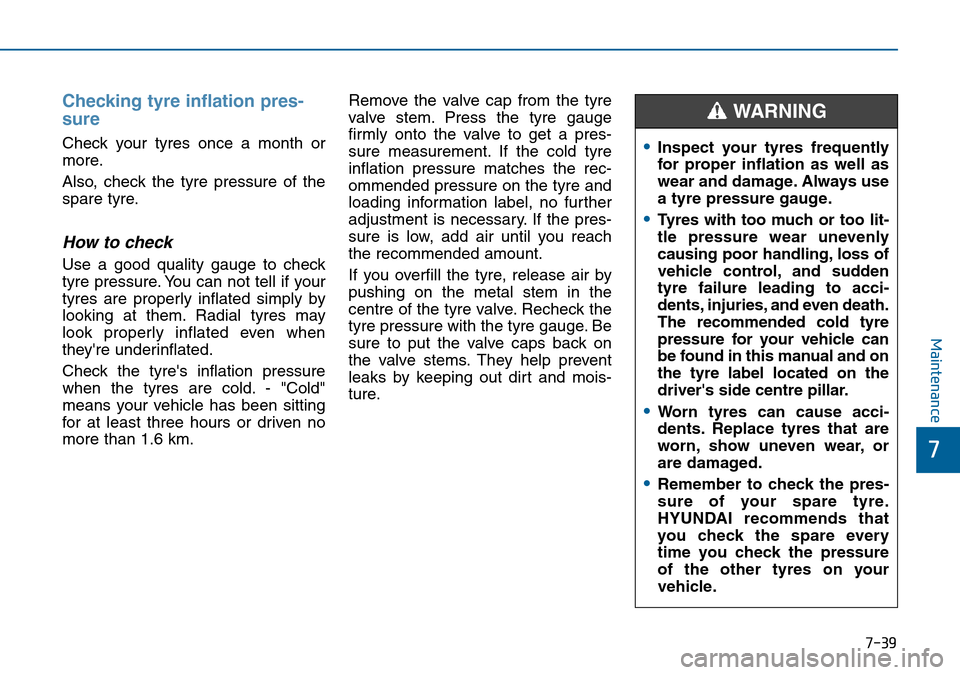
7-39
7
Maintenance
Checking tyre inflation pres-
sure
Check your tyres once a month or
more.
Also, check the tyre pressure of the
spare tyre.
How to check
Use a good quality gauge to check
tyre pressure. You can not tell if your
tyres are properly inflated simply by
looking at them. Radial tyres may
look properly inflated even when
they're underinflated.
Check the tyre's inflation pressure
when the tyres are cold. - "Cold"
means your vehicle has been sitting
for at least three hours or driven no
more than 1.6 km.Remove the valve cap from the tyre
valve stem. Press the tyre gauge
firmly onto the valve to get a pres-
sure measurement. If the cold tyre
inflation pressure matches the rec-
ommended pressure on the tyre and
loading information label, no further
adjustment is necessary. If the pres-
sure is low, add air until you reach
the recommended amount.
If you overfill the tyre, release air by
pushing on the metal stem in the
centre of the tyre valve. Recheck the
tyre pressure with the tyre gauge. Be
sure to put the valve caps back on
the valve stems. They help prevent
leaks by keeping out dirt and mois-
ture.
•Inspect your tyres frequently
for proper inflation as well as
wear and damage. Always use
a tyre pressure gauge.
•Tyres with too much or too lit-
tle pressure wear unevenly
causing poor handling, loss of
vehicle control, and sudden
tyre failure leading to acci-
dents, injuries, and even death.
The recommended cold tyre
pressure for your vehicle can
be found in this manual and on
the tyre label located on the
driver's side centre pillar.
•Worn tyres can cause acci-
dents. Replace tyres that are
worn, show uneven wear, or
are damaged.
•Remember to check the pres-
sure of your spare tyre.
HYUNDAI recommends that
you check the spare every
time you check the pressure
of the other tyres on your
vehicle.
WARNING
Page 451 of 504
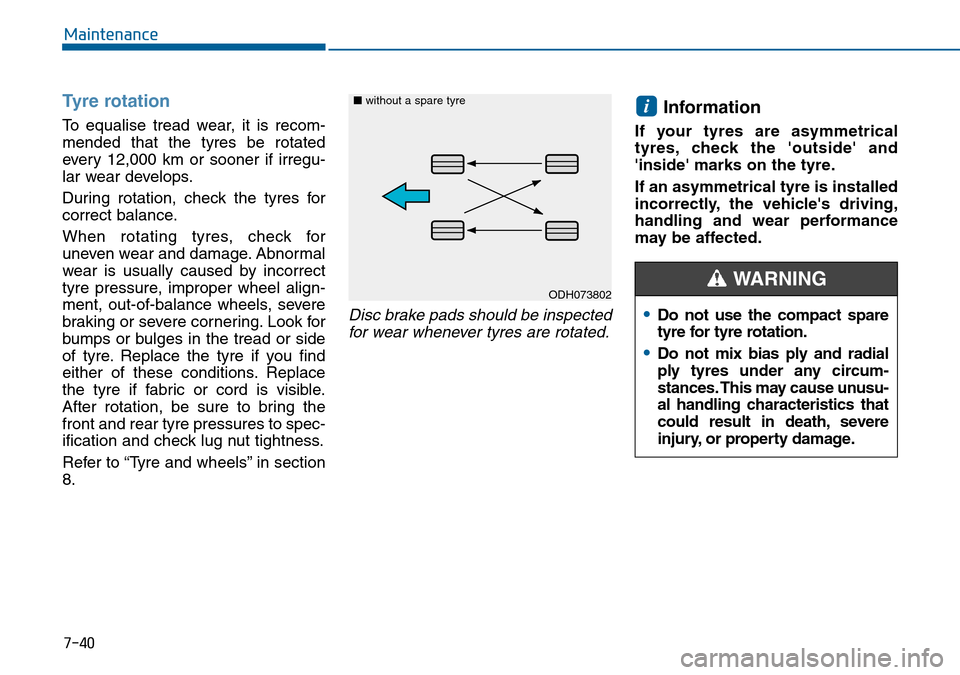
7-40
Maintenance
Tyre rotation
To equalise tread wear, it is recom-
mended that the tyres be rotated
every 12,000 km or sooner if irregu-
lar wear develops.
During rotation, check the tyres for
correct balance.
When rotating tyres, check for
uneven wear and damage. Abnormal
wear is usually caused by incorrect
tyre pressure, improper wheel align-
ment, out-of-balance wheels, severe
braking or severe cornering. Look for
bumps or bulges in the tread or side
of tyre. Replace the tyre if you find
either of these conditions. Replace
the tyre if fabric or cord is visible.
After rotation, be sure to bring the
front and rear tyre pressures to spec-
ification and check lug nut tightness.
Refer to “Tyre and wheels” in section
8.
Disc brake pads should be inspected
for wear whenever tyres are rotated.
Information
If your tyres are asymmetrical
tyres, check the 'outside' and
'inside' marks on the tyre.
If an asymmetrical tyre is installed
incorrectly, the vehicle's driving,
handling and wear performance
may be affected.
i
ODH073802 ■without a spare tyre
•Do not use the compact spare
tyre for tyre rotation.
•Do not mix bias ply and radial
ply tyres under any circum-
stances. This may cause unusu-
al handling characteristics that
could result in death, severe
injury, or property damage.
WARNING
Page 457 of 504
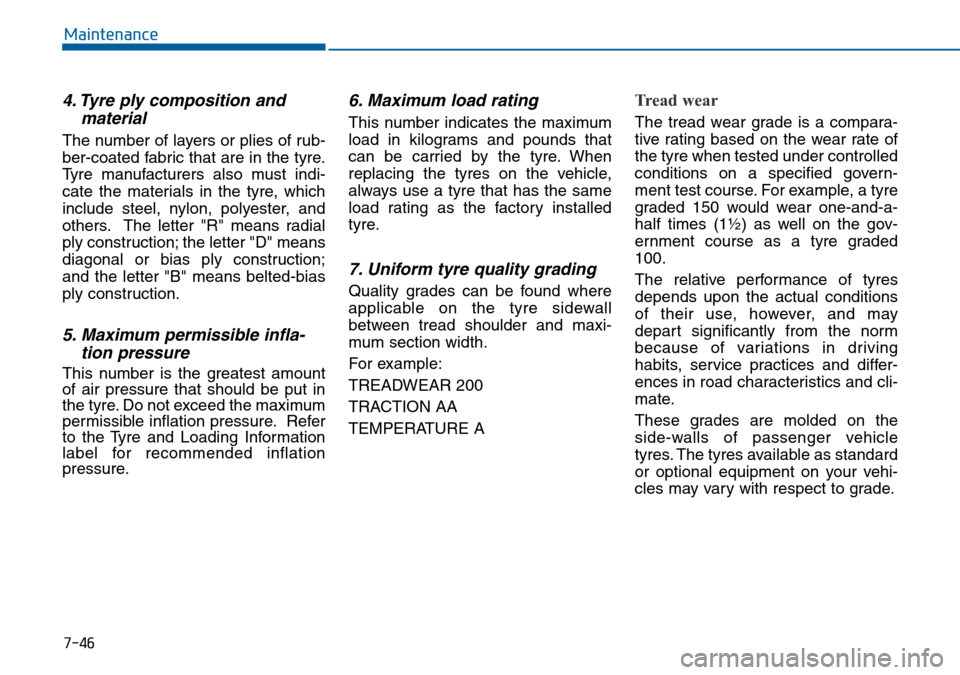
7-46
Maintenance
4. Tyre ply composition and
material
The number of layers or plies of rub-
ber-coated fabric that are in the tyre.
Tyre manufacturers also must indi-
cate the materials in the tyre, which
include steel, nylon, polyester, and
others. The letter "R" means radial
ply construction; the letter "D" means
diagonal or bias ply construction;
and the letter "B" means belted-bias
ply construction.
5. Maximum permissible infla-
tion pressure
This number is the greatest amount
of air pressure that should be put in
the tyre. Do not exceed the maximum
permissible inflation pressure. Refer
to the Tyre and Loading Information
label for recommended inflation
pressure.
6. Maximum load rating
This number indicates the maximum
load in kilograms and pounds that
can be carried by the tyre. When
replacing the tyres on the vehicle,
always use a tyre that has the same
load rating as the factory installed
tyre.
7. Uniform tyre quality grading
Quality grades can be found where
applicable on the tyre sidewall
between tread shoulder and maxi-
mum section width.
For example:
TREADWEAR 200
TRACTION AA
TEMPERATURE A
Tread wear
The tread wear grade is a compara-
tive rating based on the wear rate of
the tyre when tested under controlled
conditions on a specified govern-
ment test course. For example, a tyre
graded 150 would wear one-and-a-
half times (1½) as well on the gov-
ernment course as a tyre graded
100.
The relative performance of tyres
depends upon the actual conditions
of their use, however, and may
depart significantly from the norm
because of variations in driving
habits, service practices and differ-
ences in road characteristics and cli-
mate.
These grades are molded on the
side-walls of passenger vehicle
tyres. The tyres available as standard
or optional equipment on your vehi-
cles may vary with respect to grade.
Page 459 of 504
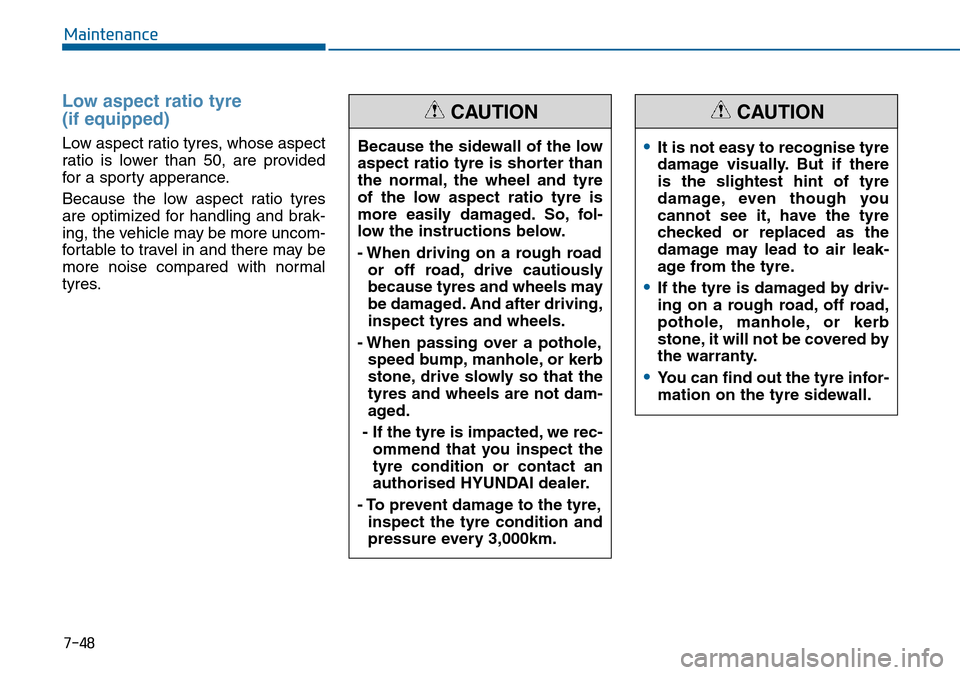
7-48
Maintenance
Low aspect ratio tyre
(if equipped)
Low aspect ratio tyres, whose aspect
ratio is lower than 50, are provided
for a sporty apperance.
Because the low aspect ratio tyres
are optimized for handling and brak-
ing, the vehicle may be more uncom-
fortable to travel in and there may be
more noise compared with normal
tyres.Because the sidewall of the low
aspect ratio tyre is shorter than
the normal, the wheel and tyre
of the low aspect ratio tyre is
more easily damaged. So, fol-
low the instructions below.
- When driving on a rough road
or off road, drive cautiously
because tyres and wheels may
be damaged. And after driving,
inspect tyres and wheels.
- When passing over a pothole,
speed bump, manhole, or kerb
stone, drive slowly so that the
tyres and wheels are not dam-
aged.
- If the tyre is impacted, we rec-
ommend that you inspect the
tyre condition or contact an
authorised HYUNDAI dealer.
- To prevent damage to the tyre,
inspect the tyre condition and
pressure every 3,000km.
CAUTION
•It is not easy to recognise tyre
damage visually. But if there
is the slightest hint of tyre
damage, even though you
cannot see it, have the tyre
checked or replaced as the
damage may lead to air leak-
age from the tyre.
•If the tyre is damaged by driv-
ing on a rough road, off road,
pothole, manhole, or kerb
stone, it will not be covered by
the warranty.
•You can find out the tyre infor-
mation on the tyre sidewall.
CAUTION
Page 496 of 504
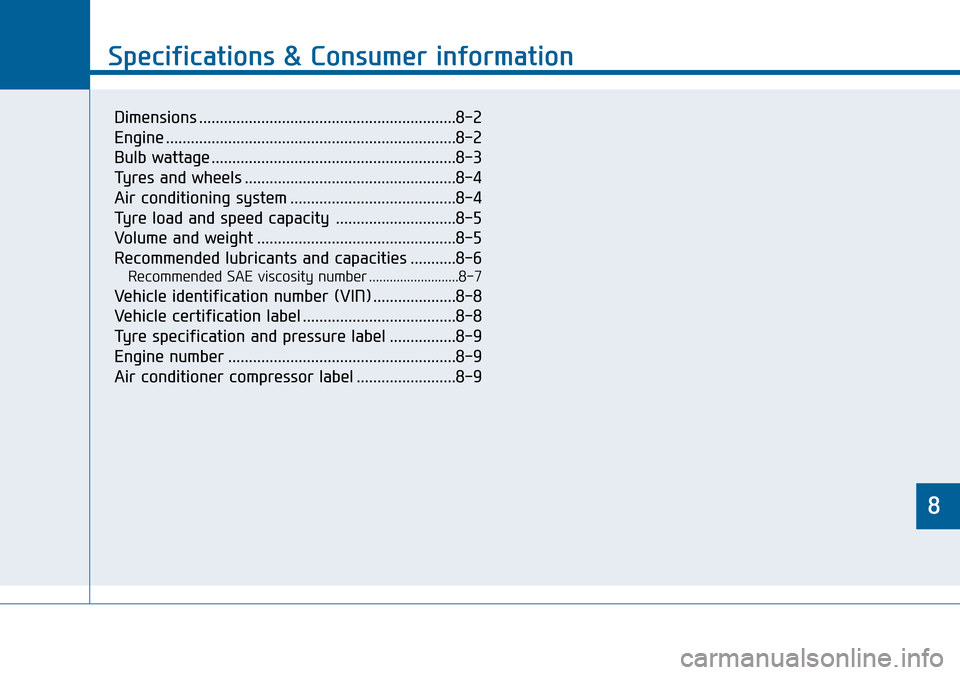
8
Specifications & Consumer information
8
Specifications & Consumer information
8
Dimensions ..............................................................8-2
Engine ......................................................................8-2
Bulb wattage ...........................................................8-3
Tyres and wheels ...................................................8-4
Air conditioning system ........................................8-4
Tyre load and speed capacity .............................8-5
Volume and weight ................................................8-5
Recommended lubricants and capacities ...........8-6
Recommended SAE viscosity number ..........................8-7
Vehicle identification number (VIN) ....................8-8
Vehicle certification label .....................................8-8
Tyre specification and pressure label ................8-9
Engine number .......................................................8-9
Air conditioner compressor label ........................8-9
Page 499 of 504
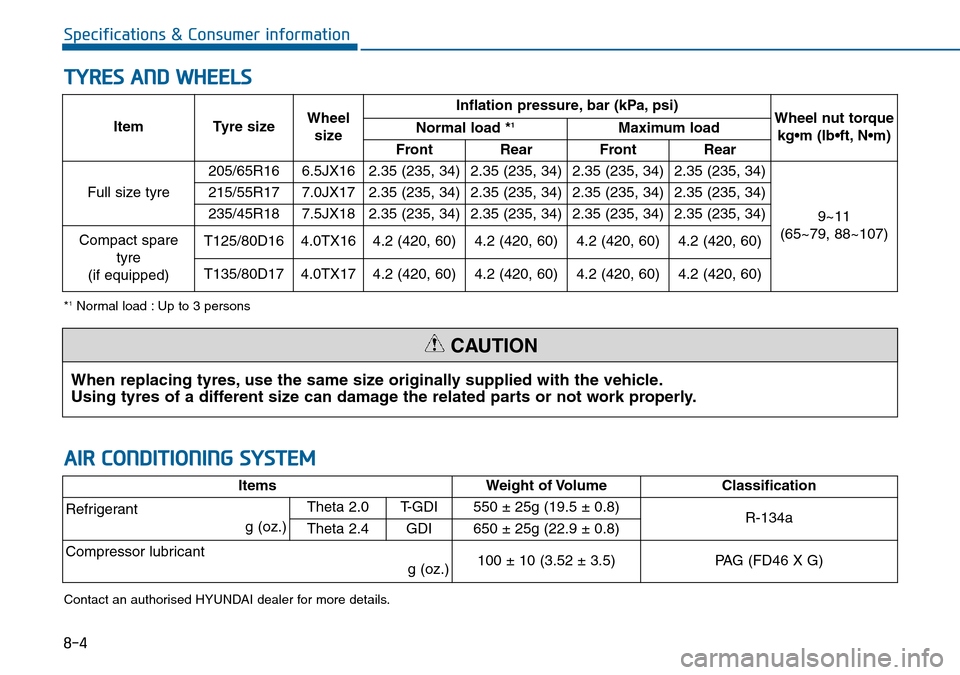
8-4
Specifications & Consumer information
TYRES AND WHEELS
Item Tyre sizeWheel
sizeInflation pressure, bar (kPa, psi)
Wheel nut torque
kg•m (lb•ft, N•m) Normal load *1Maximum load
Front Rear Front Rear
Full size tyre205/65R16 6.5JX16 2.35 (235, 34) 2.35 (235, 34) 2.35 (235, 34) 2.35 (235, 34)
9~11
(65~79, 88~107) 215/55R17 7.0JX17 2.35 (235, 34) 2.35 (235, 34) 2.35 (235, 34) 2.35 (235, 34)
235/45R18 7.5JX18 2.35 (235, 34) 2.35 (235, 34) 2.35 (235, 34) 2.35 (235, 34)
Compact spare
tyre
(if equipped)T125/80D164.0TX164.2 (420, 60)4.2 (420, 60)4.2 (420, 60)4.2 (420, 60)
T135/80D174.0TX174.2 (420, 60)4.2 (420, 60)4.2 (420, 60)4.2 (420, 60)
When replacing tyres, use the same size originally supplied with the vehicle.
Using tyres of a different size can damage the related parts or not work properly.
CAUTION
*1Normal load : Up to 3 persons
AIR CONDITIONING SYSTEM
ItemsWeight of Volume Classification
Refrigerant
g (oz.) Theta 2.0T-GDI550 ± 25g (19.5 ± 0.8)R-134aTheta 2.4GDI650 ± 25g (22.9 ± 0.8)
Compressor lubricant
g (oz.) 100 ± 10 (3.52 ± 3.5)PAG (FD46 X G)
Contact an authorised HYUNDAI dealer for more details.
Page 504 of 504
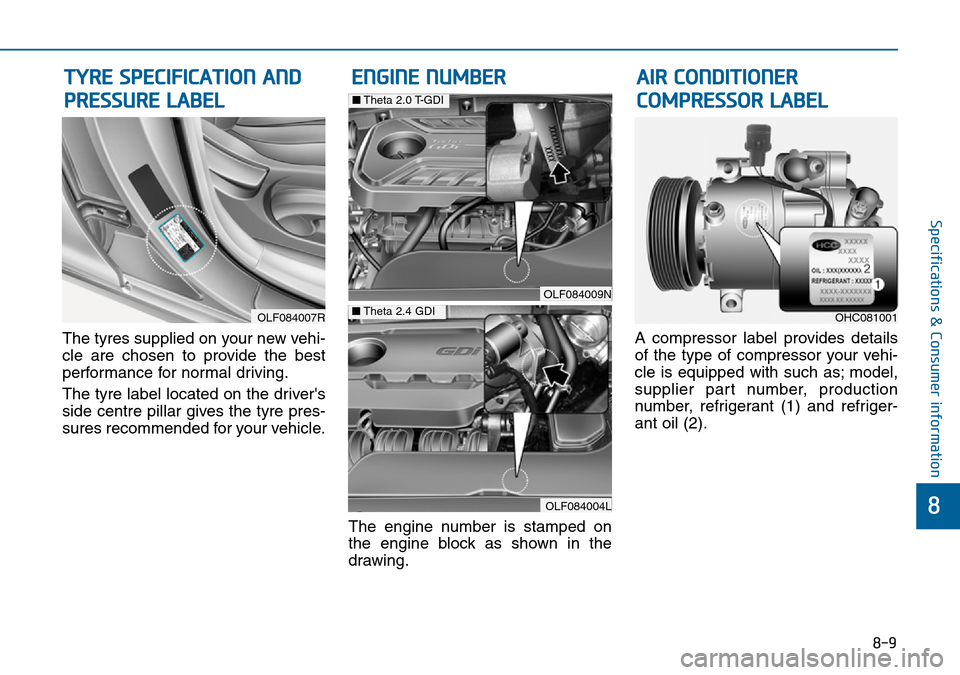
8-9
8
Specifications & Consumer information
The tyres supplied on your new vehi-
cle are chosen to provide the best
performance for normal driving.
The tyre label located on the driver's
side centre pillar gives the tyre pres-
sures recommended for your vehicle.
The engine number is stamped on
the engine block as shown in the
drawing.A compressor label provides details
of the type of compressor your vehi-
cle is equipped with such as; model,
supplier part number, production
number, refrigerant (1) and refriger-
ant oil (2).
TYRE SPECIFICATION AND
PRESSURE LABELENGINE NUMBER
OLF084007R
OLF084004L
■Theta 2.4 GDI
OLF084009N
■Theta 2.0 T-GDI
OHC081001
AIR CONDITIONER
COMPRESSOR LABEL